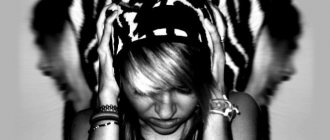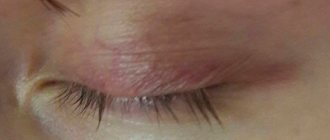Mental disorders arise for various reasons, many of which have not yet been sufficiently studied by doctors and scientists. It is believed that such diseases manifest themselves in people who have a certain genetic predisposition, but only against the background of unfavorable environmental factors.
Speaking about what paranoia is, doctors note that such a disorder is characterized by the formation of delusions that negatively affect social, work activity and personality. In the treatment of this condition, psychotherapeutic techniques and a number of medications are used to suppress the symptoms of a paranoid state.
What it is
Paranoia is an instinct strongly influenced by anxiety or fear, often to the point of delusion. This fear begins with a slight feeling of discomfort, gradually progresses and reaches an anxious way of thinking. This suggests that the mental well-being of the individual is under serious threat. At the same time, the adequacy of perception and logic of thinking in areas not related to painful ideas is preserved.
The term "paranoia" when translated from Greek means madness.
Psychosis is manifested by beliefs of persecution or self-conspiracy. Aggressive impulses change and are attributed to others in a form changed beyond recognition. The disease is expressed by a general distrust of others and false accusations. For example, a paranoid person thinks that the incident happened intentionally, while most people view it as an accident or coincidence.
Paranoia borderline state
This happens to many people. Even if a person knows that their problems are not based in reality, they can be bothersome if they happen too often. But the clinical form is a more severe pathology. This is a persistent state of constant and unfounded mistrust. This is a rare form of mental health in which the sufferer believes that others are unfair, lying and trying to harm him. Such patients do not consider themselves paranoid because they are convinced that they are right.
International Classification of Diseases
If you turn to the official international classification ICD-10, you will find that paranoia itself is not a disease. Only paranoid-type disorders that arise in the presence of other mental illnesses are considered. Is this the right approach? Unknown. But previously, paranoia within the framework of classical psychiatry was considered as an independent disease.
Symptoms and signs of paranoia
Paranoia is a central symptom of psychosis, which is manifested by a tendency to attribution (explaining the reasons for the behavior of others). Such people have a biased perception of reality, often displaying hostile beliefs. The paranoid person views random behavior as intentional or threatening. He is so carried away by delusional ideas that they cover his painful consciousness.
Other paranoid signs include:
- anxiety, fear;
- inability to compromise, forgive, accept criticism;
- jealousy;
- lack of trust in others;
- searching for hidden meanings in the normal behavior of others;
- belief in one's own rightness;
- conviction in some “conspiracy theory”;
- inability to relax, relax vigilance.
A study of paranoid populations revealed the dominant symptoms of pathology: a feeling of helplessness, depression, isolation, as well as changes in gait, facial expressions and gestures. Such individuals cannot establish interpersonal relationships due to suspiciousness and a number of other unpleasant personality traits.
Traumatic life situations complicate the situation
Dysfunction is aggravated under the influence of grief, failures: problems at work, deterioration of family relationships, divorce, financial problems, death of loved ones. Such traumatic situations complicate the patient's delusional system. At the same time, manic thoughts affect only one area of life; in other matters the patient is adequate and logical.
Types of paranoia
The type of psychosis is determined by the severity of symptoms:
- Paranoid personality disorder is the mildest manifestation. Most people with this disorder live normal lives, despite their distrust of the world. Signs associated with this dysfunction are found throughout most of an individual's life.
- Delusional (paranoid) disorder. When one false belief dominates without other symptoms of mental illness. Behavior depends on the type of delusion. For example, an individual with persecutory delusions believes that other people are spying on him and want to harm him. Or the patient imagines that he has a fatal pathology.
- Paranoid schizophrenia is the most severe type. Expressed by strange delusions, for example, the belief that thoughts are broadcast on the radio. This condition is also characterized by bizarre hallucinations. A patient with such schizophrenia finds the world confusing. To improve the patient’s quality of life, correct therapy is necessary.
The concept of “paranoia” was first used by a psychiatrist from Germany, Karl Ludwig Kahlbaum, in 1863.
The type of fixation determines the category of paranoia:
- persecution mania;
- delusions of grandeur;
- religious - the patient considers himself a messenger of God;
- reformist - thinks that he is the main reformer;
- erotic;
- hypochondriacal – believes in the presence of diseases;
- involutional - during menopause;
- expansive - believes that he is a genius in the field of culture and science;
- sensitive – against the background of brain injuries.
There is also a distinction between alcoholic and drug psychosis.
FAQ
To study the issue in this article in more detail, it is necessary to consider the most common questions that arise in relation to paranoid disorder. Let's look at the answers to these popular questions.
What to do if paranoia strikes suddenly
When paranoia appears suddenly, the following questions need to be answered:
- Did she really appear suddenly?
- What are the causes of paranoia?
- Is this situation a transition from a mild to an acute form?
In any case, the best decision would be to consult a psychiatrist for help. It is he who will be able to accurately diagnose this disease and offer you a treatment path.
However, if by surprise you mean being discovered and somewhat surprised by it, then you can try to deal with paranoia on your own. But it is important to remember that when self-medicating, you take responsibility for the fact that the disease can be neglected.
What to do if paranoia develops in a child or teenager
In the case of children, it is most important to see a doctor immediately. Due to the fact that children and adolescents have an unstable and weak psyche, they cannot properly assess the situation. Moreover, they are unlikely to suspect they are paranoid. As a parent, you need to explain to your child that medical help is necessary. Do not pressure or threaten under any circumstances. Try to make contact, show empathy and love. You need to become a helper and protector in the eyes of your child.
Is it possible to remove the problem with medication?
Yes, medications solve problems of paranoia. This has already been discussed. However, this decision is made by the attending physician. He will write out special antipsychotics according to your prescription. Therefore, you still have to see a doctor.
There are different treatment options for paranoia
Development of paranoia
In general, we have already talked about how exactly paranoia develops. But let's list these stages again:
- The emergence of an idea;
- The idea develops into an obsessive and manic thought;
- Under its influence, thinking and perception of reality changes;
- It develops into delirium that haunts a person constantly;
- The worldview, human behavior, and character change.
What are the main ways to treat paranoia?
There are two main methods of treatment:
Medication
Therapy
The specific method of treatment is determined by the doctor. These two methods can be combined. This increases the effectiveness of treatment.
What is the difference between paranoia and schizophrenia
The difference between the violations lies in their manifestations. Both diseases are dangerous both for the patient and for society. Paranoia is a feeling of anxiety, overwhelming fear and threats. An individual with such a diagnosis is sure that he is hated and persecuted. And schizophrenia is a personality disorder that entails disturbances in perception, behavior and thinking.
Among the differences between psychosis and schizophrenia are:
- Mania of persecution. The paranoid is suspicious, but the schizophrenic himself will pursue.
- Number of invented ideas. The paranoid has only one goal, the schizophrenic has many.
- Interest in what is happening. In psychosis, the patient is suspicious of the world around him; in schizophrenia, he is only interested in himself.
- Way of thinking. A schizophrenic has a creative disposition, while a paranoid has a narrow range of interests.
- Interpersonal relationships. The paranoid is cruel to others, the schizophrenic is softer.
And when paranoia manifests itself as delusions and hallucinations, a new diagnosis appears - paranoid schizophrenia.
Causes of paranoia
Paranoia is not a disease, but a symptom of a number of conditions whose causes are unclear. Scientists believe that the deviation is associated with a response to stress. Also important are the initial personality characteristics and the stereotypes of interpretation of situations developed since childhood.
Other factors that provoke the disorder include:
- Pathologies that affect the brain - Alzheimer's disease, Parkinson's disease, epilepsy, stroke, brain tumors, Huntington's disease.
- Exposure to toxins and chemicals (such as pesticides).
- Family history of mental illness or experience of childhood abuse.
- Head injuries.
- Poor living conditions.
- Insomnia.
- Social isolation.
- Taking or replacing medications.
- Abuse or withdrawal of alcohol and drugs.
Older people are more likely to experience delusional thinking as a result of age-related changes in hearing, vision, and other senses.
About the disease
Epidemiological studies indicate that this diagnosis is made in 0.1-1% of cases of patient hospitalization in psychiatric institutions. The prevalence of paranoia determines its relevance, since the immediate causes of the development of delusions cannot always be established, and signs of the disease can be detected in patients who did not have risk factors.
With paranoia, thinking disorders occur, characterized by the appearance of delusions. However, other areas of mental life are preserved, which ensures long-term normal functioning in society and later seeking medical help.
The occurrence of paranoid delusions is not detected by surrounding people and doctors for a long time. Diagnosis is often associated with a severe flare-up of the disorder associated with severe life stress. It is important to note that many relatives and colleagues of the patient may interpret his behavior and thoughts as personality traits, thereby preventing early detection of the disease.
Diagnosis of paranoia
The condition causing the pathology is difficult to determine. A clear sense of mistrust is a feature common to a number of mental disorders, and is also found in individuals with dementia. Another problem is that a patient with delusional ideas avoids doctors and hospitals, fearing that he will be harmed. Most patients first come to the doctor at the time of serious exacerbations, when their social situation deteriorates sharply.
To make a diagnosis, the doctor:
- studies anamnesis;
- examines the patient;
- evaluates pathological manifestations;
- psychologically tests the individual to rule out other mental disorders.
The patient will also need to undergo a general blood test and hormone tests, an ECG, an angiogram and an MRI of the brain. The diagnosis is confirmed if delusional ideas torment the patient for a month or more.
Pathology is often detected as part of other mental illnesses: dementia, depression, personality disorders, alcohol withdrawal, brain tumors.
Diagnostic criteria
For a doctor to diagnose schizophrenia, a person must continually show signs of the disorder for at least 6 months. This may include:
- rave
- hallucinations
- disorganized speech
- social and professional dysfunction
- extremely disorganized or catatonic behavior
- lack of pleasure in everyday life
A doctor may only diagnose schizophrenia if these signs cannot be explained by any other conditions, such as drug and alcohol abuse or a mood disorder. In general, it may take some time for a diagnosis to be made.
Treatment of the disorder
Depending on the severity of symptoms, therapy is carried out on an outpatient basis or in a hospital setting. The main method of treatment is pharmacotherapy. Patients consider the psychiatrist an enemy, so psychotherapy is ineffective; the decision about reasonableness is made by the doctor.
A common type of psychotherapy is called cognitive behavioral therapy. It helps you learn and adjust thought patterns and attitudes that change behavior. The idea is to break the cycle of anxiety with anxiety management techniques and behavior modification in areas of daily life. The disease does not respond immediately to such treatment because, due to psychosis, the patient does not cooperate with the doctor.
Depending on the severity of the condition, the patient is prescribed psychotropic drugs:
- neuroleptics;
- tranquilizers;
- sedatives;
- antidepressants.
The main treatment is atypical antipsychotics with cumulative action. The drugs maintain a constant level of antipsychotics in the blood and reduce the amount of daily dosage.
Complex treatment leads to remission and temporarily normalizes the patient’s life. But the individual will have to constantly monitor the condition, reacting in time to attacks.
Therapeutic approaches
Relatives of the patient often ask doctors whether paranoia can be treated? With the proper use of medications and psychotherapy, symptoms can be significantly reduced or disappear completely. It should be noted that if you refuse therapy, a relapse is possible.
Treatment can be carried out either on an outpatient basis for mild symptoms, or during hospitalization in a psychiatric clinic. An important element in effective therapy is the use of drugs:
- antipsychotic drugs characterized by anti-delirium action (the most commonly used are Fluanxol and Clozapine);
- the use of tranquilizers and antidepressants (Fluoxetine, Amitriptyline) is indicated for excessive agitation or the development of depression, respectively;
- individual therapy within the framework of a positive or cognitive-behavioral direction allows us to identify pathological judgments and methods of their formation, in cases where the patient understands that such conclusions contradict logic and have no real reasons, remission is observed during paranoid disorder (it should be noted that most patients experience negative feelings and transfer their delusional ideas to the psychotherapist, which significantly complicates the therapy process);
- when delusions of jealousy are identified, family psychotherapy is recommended to normalize relationships within a family or couple;
- sedatives from herbal and chemical production are used in treatment in the early stages of the disease, when it is possible to combat paranoia with the help of “light” medications.
Medicines are always prescribed by a doctor, since the drugs have indications and contraindications for their use. In severe cases of delirium, it is possible to use complex drug therapy using drugs from various pharmacological groups.
Relatives should know how to behave with a paranoid person. Psychiatrists make the following recommendations:
- If a relative exhibits symptoms consistent with paranoid disorder, you should consult with your doctor about additional diagnostic tests and procedures.
- One should not contradict a person in his judgments, despite the fact that the ideas of nonsense do not have any justified reasons or logical judgments. Otherwise, the patient may begin to view the person as a threat to his or her identity.
- It is necessary to create a comfortable atmosphere in the family and listen to the patient, however, one should never accept his conclusions, since in this case the development of induced delirium in a healthy person is possible.
The development of paranoid disorder in a family member is a serious condition that brings significant psychological discomfort. In order to find out how to get rid of paranoia, you need to consult a medical specialist, since self-medication is unacceptable.
Folk remedies for treating paranoia
Alternative therapy should be started after consultation with a doctor. Medicinal plants are used in parallel with medications. But treatment of the disorder using traditional methods is possible only in the initial stages; in advanced cases, hospitalization is indicated for the paranoid.
The effect of therapy is enhanced by the following herbal raw materials:
- Geranium. Grind 200 g of young shoots of the plant, place in a teapot with a spout and put a rubber tube on this spout. Then place the dish on the stove, lowering the tube into the glass. Keep the kettle on low heat for 3 hours. Dilute a couple of drops of the resulting product in a glass of water, take 2 times a day.
- Ginger. Grind the tubers of the plant. The resulting powder is taken as follows: dilute 10 g in boiled milk, drink 3 times a day.
- Plant complex. Mix dried hawthorn, oregano, hops, St. John's wort, lilac and cucumber. Boil 30 g of the mixture in half a liter of water, and leave the resulting mixture for 12 hours. In the morning, drink 100 ml of infusion. The course of treatment lasts 60 days.
Exotic plants also used include ashwagandha (Indian ginseng, an adaptogen that fights stress) and brahmi (a brain tonic that improves memory).








